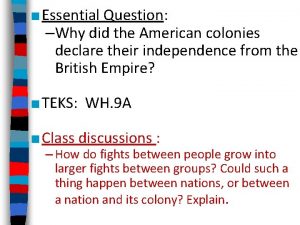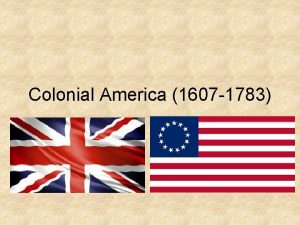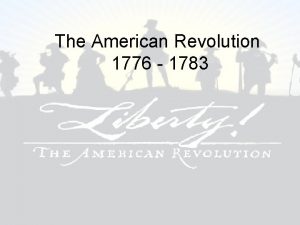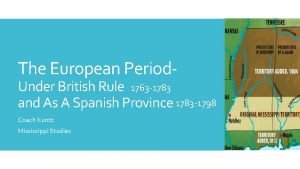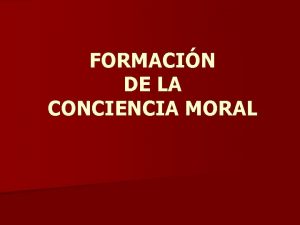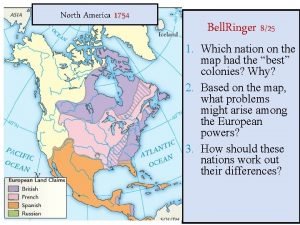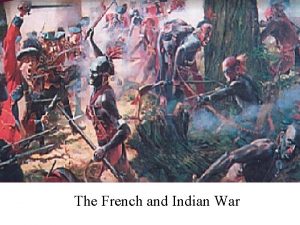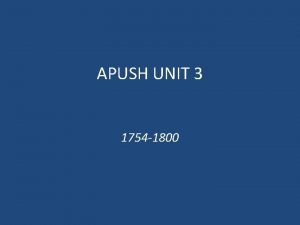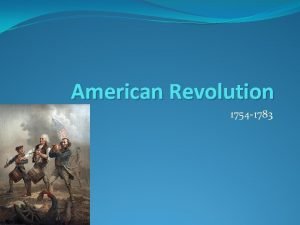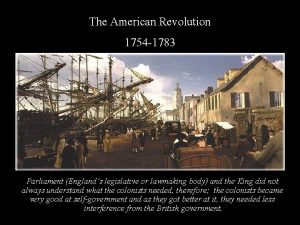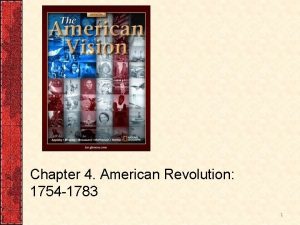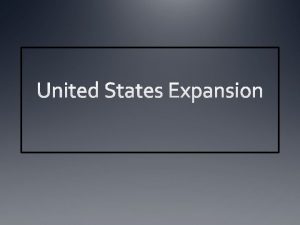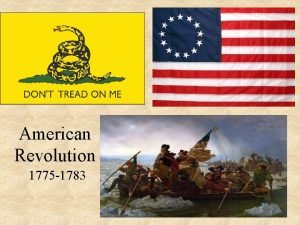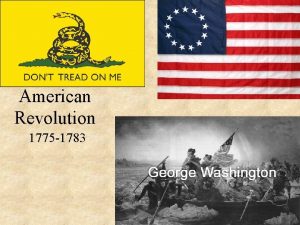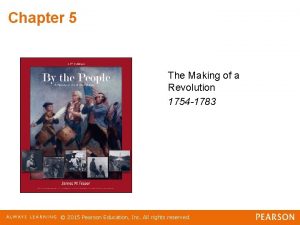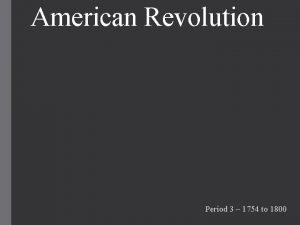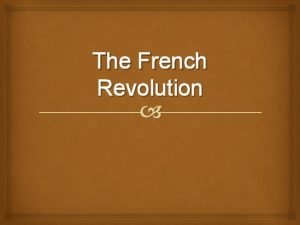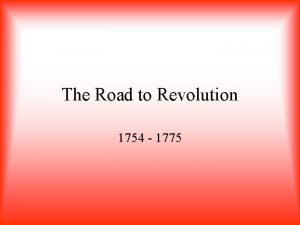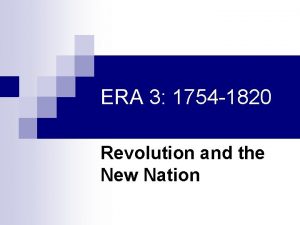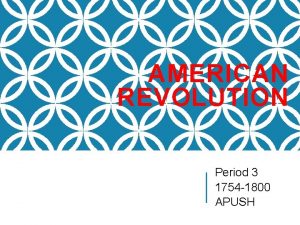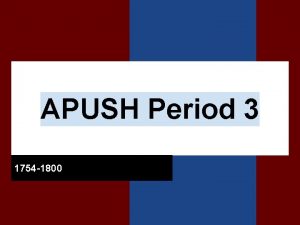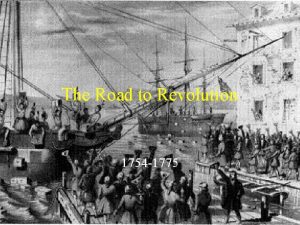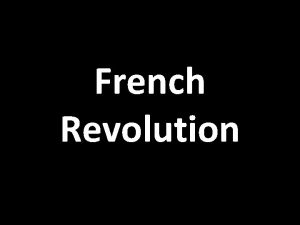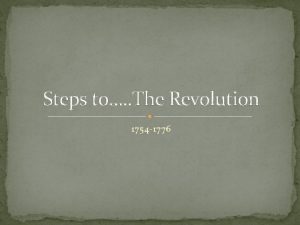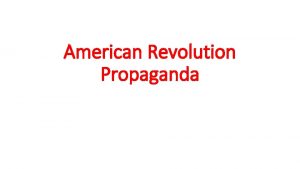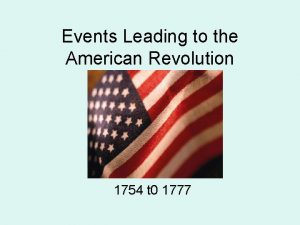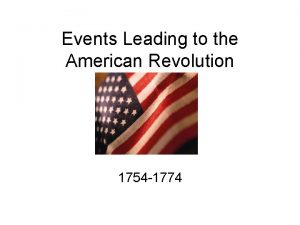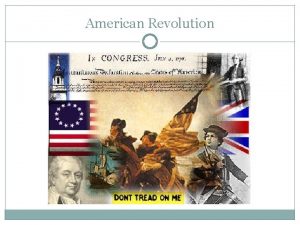The Making of a Revolution 1754 1783 2015
































- Slides: 32

The Making of a Revolution 1754 -1783 © 2015 Pearson Education, Inc. All rights reserved.

Preludes to a Revolution The French and Indian War, 1754– 1763. © 2015 Pearson Education, Inc. All rights reserved.

The French and Indian War, 1754– 1763 • The war changed the landscape of North America. • After the British victory, France ceded Canada and the land east of the Mississippi River to the British. © 2015 Pearson Education, Inc. All rights reserved.

North America Before and After the French and Indian War © 2015 Pearson Education, Inc. All rights reserved.

Causes: • Europe 1740: Great Britain attacks French and Austrians the British capture Nova Scotia. • The British Drama Spills over into North America • British & Iroquois vs. French & Huron • The British decide they want to expand their power westward • The French build Ft. Duquesne basically deep into British territory

Milestones: Albany Plan of Union • Albany Plan of Union: Beginning of the American Republic in 1754. • A meeting of colonists & Indians ( Iroquois) to plan the war • 1 st time the colonists meet to attempt to unite • Ban together military to protect each other from the French and Indians. • Plan a self imposed tax system to raise money for the common defense • • They sent their plan to the colonial assembly & to Great Britain • They BOTH shot down the plan, NOT ONE COLONY AGREED !!! NO UNITY !!!

Milestones continued • Washington ( Ft. Necessity) gets his butt kicked trying to capture Ft. Duquesne…. This is the spark that begins the 7 Years War to North America !!!! • William Pitt British secretary of state during the French and Indian War • Pitt resolved to commit whatever resources were necessary to defeat the French in North America and on the European continent. • Under Pitt the British again attack and defeat the French and take Ft. Duquesne. • 1763 Paris Peace Settlement basically gives North America to the British

Effects: • Colonists realize the British AREN’T AWESOME • Brits looked down at the Colonists. Even the military • Indian resentment…. They will side with the Brit in the Am. Rev. • Proclamation 1763 !!! • Colonists weren’t allowed to move west of the that line. • British Raise Taxes because of huge debt

The Proclamation Line of 1763 • In October 1763, the king issued a proclamation that there should be no British settlement west of the crest of the Appalachian Mountains and that Indian rights to western lands would be protected forever. • The line infuriated the British colonists. © 2015 Pearson Education, Inc. All rights reserved.

CLASS DIFFERENCES…. • Bacon’s Rebellion • Pontiac’s Rebellion • The Paxton Boys • The Regulators • All are examples of class conflict and how the lower class feels disenfranchised • Tax, debtors prison, no vote, no holding office

Pontiac and Indian Responses… • 1763 – Pontiac’s Rebellion: Pontiac and his followers attacked British forts across the region. • Eight forts were destroyed, and hundreds of colonists were killed or captured, with many more fleeing the region. • Hostilities came to an end after British Army expeditions in 1764 led to peace negotiations over the next two years. • Native Americans were unable to drive away the British, but the uprising prompted the British government to modify the policies that had provoked the conflict. • **The Rebellion was a reflection of a growing divide between the separate populations of the British colonists and Native Americans © 2015 Pearson Education, Inc. All rights reserved.

The Paxton Boys and Rural White Responses • The Paxton Boys decided to eliminate Indians. • In December 1763, the Paxton Boys attacked a Delaware village, killed six people, and burned the town. • Hatred of Indians would haunt the inhabitants of North America for a long time to come. © 2015 Pearson Education, Inc. All rights reserved.

Threats of New Taxes • Victory in the war had virtually drained the kingdom’s treasury. • In 1764, George Grenville and the majority in Parliament asked Britain’s North American colonists to pay what the authorities in London thought was a fair share of the war’s cost. © 2015 Pearson Education, Inc. All rights reserved.

“The Revolution Was in the Minds of the People” • According to John Adams, “The Revolution was in the minds of the people, and this was effected from 1760 to 1775, fifteen years before a drop of blood was shed at Lexington. ” • The revolutionary change took place for many reasons. ANTI-REVOLUTION: • Loyalists • African Slaves: offered freedom by both • Native Americans : bc British didn’t want to move west © 2015 Pearson Education, Inc. All rights reserved.

Transition from the “Rights of Man” to Revolt • Throughout the 1770 s, Locke’s ideas guided some of the Revolution’s most articulate advocates • Thomas Jefferson, John Adams, and Benjamin Franklin. • They also believed in the need to overthrow unjust authorities. • Republicanism: A complex, changing body of ideas values, and assumptions that held that selfgovernment by the citizens of a country or their representatives provided a more reliable foundation for the good society and individual freedom than ruled by kings or any other distant elite. • “America has set the example and France has followed it, of charters of power granted by liberty. ” – James Madison © 2015 Pearson Education, Inc. All rights reserved. • • Multiple revolutions are happening around the world: French Revolution 1789 – 1799 Haitian Revolution 1791 Latin American Revolutions 1810 - 1826

The Accompanying Revolution in Religion • 1740 - Gilbert Tennant challenged the leaders of all Protestant denominations to judge their ministers. • He was calling out to congregations that were not “pro-awakening” to challenge their ministers • It was not a great leap to challenge civil authority as well. • Ideas, Belief, and Culture © 2015 Pearson Education, Inc. All rights reserved.

From the Stamp Act to the Boston Massacre and Boston Tea Party • British actions in the 1760 s & 1770 s escalated tensions in North American cities. • The gov’t needed to pay off the debt from the F&I war, and with each attempt the resistance grew • 1764 – Sugar Act • 1765 – The Stamp Act (SON’S OF LIBERTY: formed an underground resistance to the acts) • Any paper product…wills, playing cards, licenses, etc…. . well to do people had to pay the tax • First direct revenue tax on the Colonists !!! Paid by the people, as opposed to merchants • 1767 – Townshend duties – second attempt on a variety of goods…paper, lead, paint, tea… • © 1773 – Tea Act …. 2015 Pearson Education, Inc. Gave a monopoly to the Brit East India company All rights reserved.

Cont…. • Colonists saw each tax and act and an attack on their civil liberties. • March 5 th 1770 – Boston Massacre (5 died) – Paul Revere’s engraving…propaganda, drunk dock workers. Calm for 3 years until the Tea Act • 1773 – Boston Tea Party (probably the most famous act of resistance) • Result… the Intolerable Acts were passed in response to the event. ( Coercive Acts and Quebec Act) • Daughters of Liberty: Women’s response to the Sons of liberty, they opposed British measures, avoided British taxed tea, spun their own yarn and wove their own cloth to avoid purchasing British goods. The main purpose of these societies was to intimidate tax agents/collectors. Tarred and feathered officials

Revolts in the Back Country • Rural people on the frontier from New York to the Carolinas were also taking matters into their own hands, but for different reasons. • They called themselves The Regulators • They violently opposed movements by the government to implement courts and offices attempting to force and punish people who didn’t pay taxes • Throughout the colonies the most contentious issue for inland communities was relationships with Indian tribes. • Colonists wanted more land than the 1763 Proclamation Line allowed. © 2015 Pearson Education, Inc. All rights reserved.

Growing Unity in the Colonies—The First Continental Congress • The colonies joined together in united action against British Tyranny • 1774 – Philadelphia, First Continental Congress: meeting of delegates from most of the colonies held in Philadelphia in 1774 in response to the British efforts to tax the colonies. • All colonies, except Georgia, sent representatives. • At the time, few were ready to break with Britain, finding common ground wasn’t easy.

Agreements of the 1 st Cont. Congress • Their natural rights should not be infringed upon • Ban on British imports • A ban on exports • A ban on the consumption of tea (symbolic) • Meet again in May 1775 if relations with Britain didn’t improve

Talk of Freedom for Slaves • Somerset Decision: 1772 ruling by Britain’s Lord Chief Justice in the case of James Somerset that set him free and essentially declared slavery illegal in England, though not in British colonies. • The Somerset decision caused a considerable stir in the colonies and in Britain. • Whites on both sides of the Atlantic noted the absurdity of colonists protesting their own perceived enslavement by Parliament while those same colonists enslaved Africans. • “thousands of tens of thousands of their fellow creatures!” • Quakers made it mandatory for members of their denomination to free their © 2015 Pearson Education, Inc. All rights reserved. slaves or allow them to purchase their freedom

The War For Independence • British Courts and Troops Stationed in the Colonies as the Revolution Began Patriots (Colonists who fought for independence from Great Britain) Loyalists (Colonists who remained loyal to Great Britain during the Revolution) “Tories” almost 60, 000 of them. © 2015 Pearson Education, Inc. All rights reserved.

From Lexington and Concord to Bunker Hill— Revolt Becomes War • April 1775 – Battles of Lexington and Concord…Catalyst • June 1775 - Battle of Bunker Hill (Breed’s Hill)…First true battle…Brits win, but had heavy losses. • After that battle, however, the American forces became better organized and gained support from all 13 colonies. Become unconventional in their fighting. © 2015 Pearson Education, Inc. All rights reserved.

African-Americans in the Armies of Both Sides • The outbreak of war opened a new avenue to freedom for American slaves. • Some heard the rumor that the British intended to help of free the African’s • In Winter 1777 -78, Washington finally embraced black volunteers. © 2015 Pearson Education, Inc. All rights reserved.

Moving Toward Independence • May 1775 – Second Continental Congress meets in Philadelphia • Delegates from the thirteen colonies met in Philadelphia to create a Continental army and prepare the colonies for war against Britain. OLIVE BRANCH PETITION. Letter seeking reconciliation. One more try !!! King never even addresses it. • Thomas Paine’s Common Sense: Common Sense was a pamphlet that attacked the British monarchy and provided a rationale for American independence from Britain. It was written in plain terms that all Colonial Americans could understand. © 2015 Pearson Education, Inc. All rights reserved.

Declaring Independence, 1776 • Thomas Jefferson writes the first draft of The Declaration of Independence • On July 4, 1776, Congress adopted it. • 1777 - Congress adopts the Articles of Confederation. Ratified in 1781 © 2015 Pearson Education, Inc. All rights reserved.

George Washington and His Victorious Patchwork Army • Washington understood that though his army could fight, they could not withstand a direct battle with British regulars. • For much of the war, his goal was not a decisive victory, but avoiding a decisive loss. • He knew the British would tire of war. © 2015 Pearson Education, Inc. All rights reserved.

Two Significant Battles • Battle of Saratoga (New York), 1777 • at attempt by the British to cut New England the South off from one another by seizing control of New York • the victory by the Continental Army convinced the French to join the war on the side of the colonists • Battle of Yorktown (Virginia), 1781 • combined French and Continental troops force the surrender of General Cornwallis and the British • the last major battle of the American Revolution • Colonial American victory forced the British to start negotiating a treaty to bring the war to an end

Treaty of Paris, 1783 • the treaty officially ended the Revolution and recognized the United States as a free, sovereign, and independent nation • Terms of the Treaty • The Great Lakes served as the northern border of the United States • The Mississippi River served as the western border of the United States • Spain retained control of Florida (obvious problems later) • Britain retained control of Canada (obvious problems later) • the United States agreed to treat the loyalists fairly in the post war years • the British agreed to remove all troops from United States territory

Major Battles of the American Revolution. © 2015 Pearson Education, Inc. All rights reserved.

VIDEOS • F&I War: https: //www. youtube. com/watch? v=Ktkw 7 i. SITkc • CC: https: //www. youtube. com/watch? v=Eytc 9 Za. NWyc&list=PL 8 d. Puua. Lj. X t. Mwmep. Bj. TSG 593 e. G 7 Obz. O 7 s&index=6 • School House Rock: https: //www. youtube. com/watch? v=t 9 p. DZMRCp. Q
 Treaty of paris 1783 apush
Treaty of paris 1783 apush British cession 1818
British cession 1818 Us in 1783
Us in 1783 Catecismo de la iglesia 1783
Catecismo de la iglesia 1783 1783-1607
1783-1607 Us in 1783
Us in 1783 Under british rule, 1763-1783
Under british rule, 1763-1783 Catecismo de la iglesia 1783
Catecismo de la iglesia 1783 North america 1754 map worksheet
North america 1754 map worksheet French territory in north america 1754
French territory in north america 1754 1754 lulu love
1754 lulu love 1754 to 1800 apush
1754 to 1800 apush Modern commercial agriculture
Modern commercial agriculture Russian revolution vs french revolution
Russian revolution vs french revolution Economic causes of french revolution
Economic causes of french revolution War making and state making as organized crime
War making and state making as organized crime What is inferring
What is inferring Cái miệng xinh xinh thế chỉ nói điều hay thôi
Cái miệng xinh xinh thế chỉ nói điều hay thôi Các châu lục và đại dương trên thế giới
Các châu lục và đại dương trên thế giới Từ ngữ thể hiện lòng nhân hậu
Từ ngữ thể hiện lòng nhân hậu Bổ thể
Bổ thể Tư thế ngồi viết
Tư thế ngồi viết Giọng cùng tên là
Giọng cùng tên là Thơ thất ngôn tứ tuyệt đường luật
Thơ thất ngôn tứ tuyệt đường luật Chúa yêu trần thế alleluia
Chúa yêu trần thế alleluia Sự nuôi và dạy con của hổ
Sự nuôi và dạy con của hổ đại từ thay thế
đại từ thay thế Diễn thế sinh thái là
Diễn thế sinh thái là Vẽ hình chiếu vuông góc của vật thể sau
Vẽ hình chiếu vuông góc của vật thể sau Phép trừ bù
Phép trừ bù Công thức tính thế năng
Công thức tính thế năng Thế nào là mạng điện lắp đặt kiểu nổi
Thế nào là mạng điện lắp đặt kiểu nổi Tỉ lệ cơ thể trẻ em
Tỉ lệ cơ thể trẻ em


